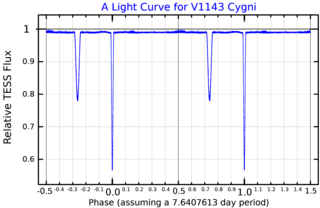
Omicron Andromedae is a star system in the constellation Andromeda. It is approximately 692 light years from Earth. The system as a whole is classified as a blue-white B-type giant, with a mean combined apparent magnitude of +3.62.
74 Aquarii is a triple star system in the constellation of Aquarius. 74 Aquarii is its Flamsteed designation and it also bears the variable star designation HI Aquarii. The combined apparent visual magnitude is 5.8, although it is very slightly variable, and it is located at a distance of 590 light-years from Earth.

2 Lacertae is a binary star in the constellation of Lacerta. With an apparent magnitude of about 4.5, it is faintly visible to the naked eye. Its parallax, measured by the Hipparcos spacecraft, is 5.88 milliarcseconds, corresponding to a distance of about 550 light years. It is projected against the Lacertae OB1 stellar association to the northeast of the main concentration of stars, but it is likely to be a foreground object.
HD 83944 is a star system in the constellation Carina. This has the Bayer designation m Carinae, while HD 83944 is the identifier from the Henry Draper catalogue. It is a suspected variable with an apparent visual magnitude that fluctuates around 4.51 with an amplitude of 0.5. The system is located at a distance of approximately 226 light years from the Sun based on parallax, and it has an absolute magnitude of 0.31. It is a member of the Carina association of co-moving stars.

Nu Centauri, Latinized from ν Centauri, is a binary star system in the southern constellation of Centaurus. The combined apparent visual magnitude of the pair is +3.41, making this one of the brightest members of the constellation. Based upon parallax measurements made during the Hipparcos mission, this star system is located at a distance of roughly 437 light-years from Earth. The margin of error for this distance is about 2%, which is enough to give an error in distance of ±10 light years.

Gamma Persei is a binary star system in the constellation Perseus. The combined apparent visual magnitude of the pair is +2.9, making it the fourth-brightest member of the constellation. The distance to this system has been measured using the parallax technique, giving an estimate of roughly 243 light-years with a 4% margin of error. About 4° to the north of Gamma Persei is the radiance point for the annual Perseid meteor shower.

AO Cassiopeiae, also known as Pearce's Star, is a binary system composed of an O8 main sequence star and an O9.2 bright giant that respectively weigh anywhere between 20.30 and 57.75 times and 14.8 and 31.73 times the mass of the Sun.

Iota Trianguli, Latinized from ι Trianguli, is a quadruple star system in constellation of Triangulum. The pair have a combined apparent magnitude of 4.95 and are approximately 290 light years from Earth.

1 Geminorum is a star in the constellation Gemini. Its apparent magnitude is 4.15.

Sigma Geminorum is a binary star system in the constellation Gemini, just to the northeast of Pollux. It is visible to the naked eye with an apparent visual magnitude of 4.20. Its annual parallax shift of 26.08 mas indicates that it is located 125 light years from the Sun.

Tau Persei, also known as 18 Persei, is a binary star in the constellation of Perseus. The system is fairly close, and is located about 254 light-years away, based on its parallax.

48 Persei is a Be star in the constellation Perseus, approximately the 500th brightest of the visible stars in apparent magnitude. It is "well known for its complex spectrum and for its light and velocity variations". The name "48 Persei" is a Flamsteed designation given to it by John Flamsteed in his catalogue, published in 1712.

22 Orionis is a binary star in the equatorial constellation of Orion. It has the Bayer designation o Orionis, while 22 Orionis is the Flamsteed designation. This system is visible to the naked eye as a faint, blue-white hued star with an apparent visual magnitude of 4.74. It is located approximately 1,100 light years away from the Sun based on parallax. The system is moving further from the Earth with a heliocentric radial velocity of +28.80

Gamma Phoenicis is a star system in the constellation Phoenix, located around 71.63 parsecs (233.6 ly) distant.

42 Persei is a binary star system in the northern constellation of Perseus. It has the Bayer designation n Persei, while 42 Persei is the Flamsteed designation. The system is visible to the naked eye as a dim, white-hued point of light with an apparent visual magnitude of 5.11. It is located around 93 parsecs (302 ly) distant from the Sun, but is drifting closer with a radial velocity of −12.4 km/s.

21 Persei is a single, variable star in the northern constellation of Perseus, located about 331 light years away from the Sun. It is visible to the naked eye as a faint, white-hued star with an apparent visual magnitude of 5.10 km/s. The object is moving further from the Earth with a heliocentric radial velocity of +8.5 km/s. It has the variable star designation LT Persei; 21 Persei is the Flamsteed designation.

31 Cygni, also known as ο1 Cygni, Omicron1 Cygni, or V695 Cygni, is a triple star system about 750 light years away in the constellation Cygnus.

10 Persei is a blue supergiant star in the constellation Perseus. Its apparent magnitude is 6.26 although it is slightly variable.

AC Herculis, is an RV Tauri variable and spectroscopic binary star in the constellation of Hercules. It varies in brightness between apparent magnitudes 6.85 and 9.0.

HR 7484 is a binary star system in the northern constellation of Cygnus. It is dimly visible to the naked eye under good viewing conditions, having an apparent visual magnitude of 5.89. Based upon an annual parallax shift of 24.71, it is located 132 light years away. The system is moving closer with a heliocentric radial velocity of −14 km/s.













